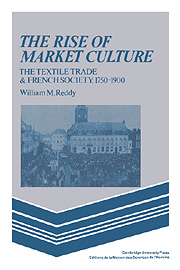Book contents
- Frontmatter
- Contents
- List of figures and maps
- List of abbreviations
- Preface
- Introduction
- Part One A world without entrepreneurs, 1750–1815
- 1 Commerce as conflict
- 2 The design of the spinning jenny
- 3 New terms and old practices
- Part Two Uses of the market idea, 1816–1851
- Part Three Unquestioned assumptions, 1852–1904
- Conclusion
- Notes
- Bibliographical note
- Index
1 - Commerce as conflict
from Part One - A world without entrepreneurs, 1750–1815
Published online by Cambridge University Press: 30 September 2009
- Frontmatter
- Contents
- List of figures and maps
- List of abbreviations
- Preface
- Introduction
- Part One A world without entrepreneurs, 1750–1815
- 1 Commerce as conflict
- 2 The design of the spinning jenny
- 3 New terms and old practices
- Part Two Uses of the market idea, 1816–1851
- Part Three Unquestioned assumptions, 1852–1904
- Conclusion
- Notes
- Bibliographical note
- Index
Summary
If entrepreneurship was not a distinct activity in eighteenth-century textile production, then one cannot expect it to have left any documentary trace. And this is indeed the case for eighteenth-century France. A few merchant manufacturers, as they are called, have left some papers behind. In reality these people (misleadingly called fabricans in eighteenth-century records) were not manufacturers at all but merchants who contracted out for certain manufacturing processes. Their accounts were kept accordingly and do not reveal the kind of calculation one would expect an entrepreneur to depend on for decision making. Philippe Guignet, for example, has found the account books of a lace-dealing enterprise in Valenciennes for the period 1748 to 1775. The Tribout family bought lace yarn, put out the yarn to individual lace makers (along with a pattern they were to follow in making the lace), and bought the finished lace back at a price negotiated on the spot on the basis of the quality and quantity of the finished product. Madame Tribout kept a single account book, entering all transactions (putting out and buying back) in chronological order. Lace makers were understood to hold their yarn on credit against return of the finished piece; the pattern too was considered to be property of the Tribouts. In theory,lace makers could sell the lace to someone else and pay off their debt; in practice the high nominal value set on yarn and pattern in Madame Tribout's books made this unprofitable. Nothing was produced or transformed on the premises.
- Type
- Chapter
- Information
- The Rise of Market CultureThe Textile Trade and French Society, 1750–1900, pp. 22 - 47Publisher: Cambridge University PressPrint publication year: 1984



